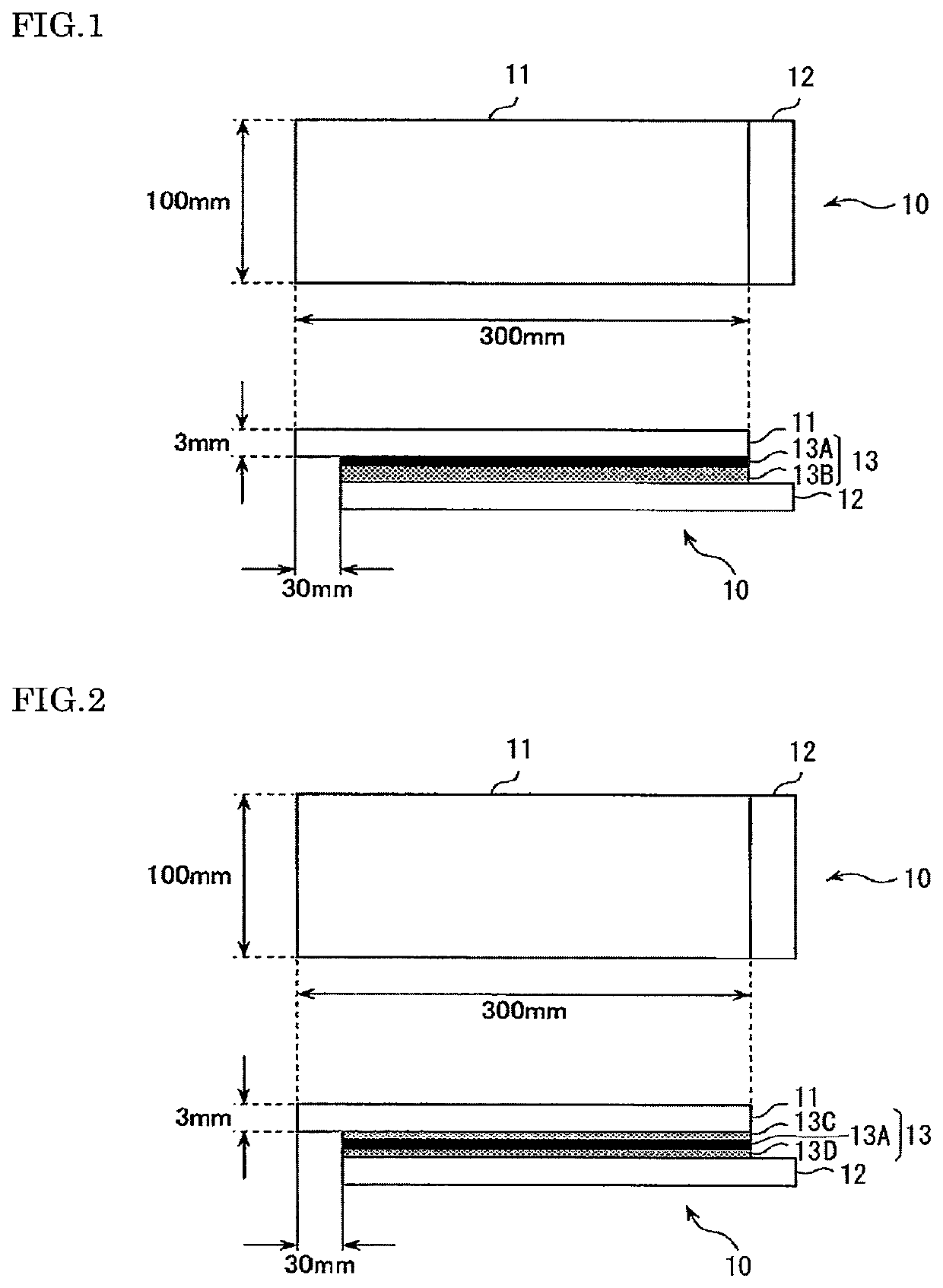Polyvinyl acetal resin film for laminated glass
a polyvinyl acetal resin and laminated glass technology, applied in the direction of synthetic resin layered products, windows, vehicle components, etc., can solve the problems of inefficient hot air application to the glass, decrease in cruising distance, and inability to obtain sufficient forward visibility, etc., to achieve excellent curved surface followability, suppress the deformation and destruction of the functional layer or the conductive layer, and high production efficiency
- Summary
- Abstract
- Description
- Claims
- Application Information
AI Technical Summary
Benefits of technology
Problems solved by technology
Method used
Image
Examples
example 1
[0220]A polyvinyl butyral resin 1 (hereinafter referred to as “resin 1”) and a polyvinyl butyral resin 2 (hereinafter referred to as “resin 2”) were blended at a mass ratio of 75:25, melt-kneaded to be extruded into strands, and pelletized. The obtained pellets were melt-extruded using a single screw extruder and a T-die, and a 50 μm-thick polyvinyl acetal resin film c with a smooth surface was obtained using a metal elastic roll.
[0221]The film forming property when the pellets were melt-extruded by a single screw extruder was evaluated based on the following criteria. The results are shown in Table 2.
[0222]A The film forming property was very good.
[0223]B Film formation was good.
[0224]C Coloring and generation of decomposition gas occurred, but film formation was possible.
[0225]D Film formation was impossible.
[0226]The resin for constituting the polyvinyl acetal resin film was analyzed by GPC. For the GPC analysis, GPCmax TDA 305 from Viscotek Corporation and a RI detector were use...
example 4
[0235]A UV-curable nano-silver ink was printed on the polyvinyl acetal resin film c by a letterpress printing method to a thickness of 10 μm, and a linear conductive material pattern having 20 lines with a line width of 300 μm, a pitch of 100 μm, and a length of 5 cm was formed. The pattern was irradiated with UV light to cure the ink.
[0236]Next, the polyvinyl acetal resin film provided with the pattern was arranged on a glass of 10 cm long, 10 cm wide, and 3 mm thick so that a printed surface faced upward, and a copper foil tape (5 mm wide and 15 cm long) having a conductive adhesive layer as a bus bar was applied so as to overlap with both ends of each linear conductive material at a right angle to the direction of the linear conductive material of the pattern. Each end of the bus bar protruded from the polyvinyl acetal resin film and was used as an electrode. Subsequently, as a plasticized polyvinyl acetal resin layer, an interlayer film for automobile windshields of 10 cm long, ...
example 7
[0251]A 7 μm thick copper foil whose one surface was blackened was layered on the produced polyvinyl acetal resin film c in such an orientation that the surface subjected to blackening (hereinafter may be referred to as the blackened surface) and the polyvinyl acetal resin film c were in contact with each other. Here, the visible light reflectance of the blackened surface measured according to JIS R 3106 was 5.2%. Next, the upper and lower sides of the layered product in which the polyvinyl acetal resin film c and the copper foil were layered were sandwiched between 50 μm thick PET films, and the layered product was passed between thermocompression bonding rolls set at 120° C. (pressure: 0.2 MPa, speed: 0.5 m / min). Then, the PET films were peeled off to obtain a polyvinyl acetal resin film to which the copper foil was bonded.
[0252]After a dry film resist was laminated on the copper foil of the produced polyvinyl acetal resin film to which the copper foil was bonded, an etching resis...
PUM
| Property | Measurement | Unit |
|---|---|---|
| thickness | aaaaa | aaaaa |
| thickness | aaaaa | aaaaa |
| thickness | aaaaa | aaaaa |
Abstract
Description
Claims
Application Information
 Login to View More
Login to View More - R&D
- Intellectual Property
- Life Sciences
- Materials
- Tech Scout
- Unparalleled Data Quality
- Higher Quality Content
- 60% Fewer Hallucinations
Browse by: Latest US Patents, China's latest patents, Technical Efficacy Thesaurus, Application Domain, Technology Topic, Popular Technical Reports.
© 2025 PatSnap. All rights reserved.Legal|Privacy policy|Modern Slavery Act Transparency Statement|Sitemap|About US| Contact US: help@patsnap.com


